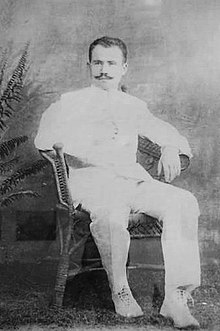This article has multiple issues. Please help improve it or discuss these issues on the talk page. (Learn how and when to remove these messages)
|
| Mario Tamagno | |
|---|---|
 | |
| Born | (1877-06-19)19 June 1877 Turin, Italy |
| Died | 1941 (aged 63–64) |
| Alma mater | Accademia Albertina di Belle Arti |
| Occupation | Architect |
| Practice | Government of Siam |
| Buildings | Ananta Samakhom Throne Hall (1908–15; collaboration) Hua Lamphong Railway Station (1907) |
Mario Tamagno (19 June 1877 – 1941) was an Italian architect who worked mainly in early 20th-century Siam (modern-day Thailand).
Biography
| This section does not cite any sources. Please help improve this section by adding citations to reliable sources. Unsourced material may be challenged and removed. (January 2025) (Learn how and when to remove this message) |
He was educated at the Albertina Academy of Fine Arts in Turin, where he became an instructor after graduating in 1895. He travelled to Siam in 1900, where he entered employment with the Siamese government in a twenty-five-year contract. He was among many Westerners, particularly Italians, who were employed as architects and civil engineers during the reign of King Chulalongkorn. He produced many works, and contributed extensively with Annibale Rigotti, most notably on the Ananta Samakhom Throne Hall.
After the term of his government contract (1900–1925), he was asked by the Siamese government to continue his work for Villa Norasing (today House of Government) during its last phase of construction, in May 1926 he returned to his homeland with a lifetime retirement income from the Government of Siam.
Notable contributions
- Makkhawan Rangsan Bridge
- Oriental Hotel
- The first office of the Siam Commercial Bank
- Private residence of Chaophraya Thammasakmontri (1899), currently operating as a cultural and civic hub called Bangkok 1899
- Phitsanulok Mansion
- Bang Khun Phrom Palace (1906)
- Suan Kularb Residential Hall and Abhisek Dusit Throne Hall in the Dusit Palace
- Hua Lamphong Railway Station (1907)
- Neilson Hays Library (1920–1922)
Collaborations with Annibale Rigotti:
- Wat Benchamabophit (under Prince Narisara Nuvadtivongs)
- Nongkhran Samoson Hall in Suan Sunanda Palace (1911)
- Siam pavilion at the 1911 Turin International world's fair.
- Santa Cruz Church (1913, reconstruction), not mentioned in Mario Tamagno's records.
- Thewarat Sapharom Throne Hall in the Phaya Thai Palace (c.1910)
References
- ธีรพันธ์ ลีลาวรรณสุข (14 February 2019). "จากบ้านเจ้าพระยาธรรมศักดิ์มนตรีสู่คาเฟ่ ศูนย์ NGO และบ้านพักของศิลปินแลกเปลี่ยนทั่วโลก: Chaopraya for all". The Cloud (in Thai). Retrieved 27 July 2024.
- "Tamagno, Mario". A World's Fair in Italy: Turin 1911. University of Virginia. Retrieved 12 February 2012.
- Lohapon, Neungreudee. Buon fratello e Amico Thailandia-Italia : 140 Anni Di Relazioni Italo-Thailandesi - ภราดามหามิตร ไทย-อิตาลี : 140 ปี ความสัมพันธ์ไทย-อิตาลี. published by The Royal Thai Embassy in Rome, printed by Amarin Printing and Publishing, Bangkok 2010.
- Noobanjong, Koompong (2003). Power, identity, and the rise of modern architecture: from Siam to Thailand. : Dissertation.com. ISBN 978-1-58112-201-5.
- Tamagno, Elena. Mario Tamagno: Twenty-five years serving the court of Siam as an architect -มาริโอ ตามานโญ.ยี่สิบห้าปีแห่งการเป็นสถาปนิกในราชสำนักสยาม (๒๔๔๓-๒๔๖๘). in Muang Boran. vol. 24. no. 2 April–June 1998.
- De Lazara, Leopoldo Ferri; Piazzardi, Paolo; Cassio, Alberto (1992). Italiani alla corte del siam–Italians at the court of Siam–ชาวอิตาเลียนในราชสำนักไทย. Bangkok: Amarin Printing and Publishing (published 1996). ISBN 978-974-8364-60-5.